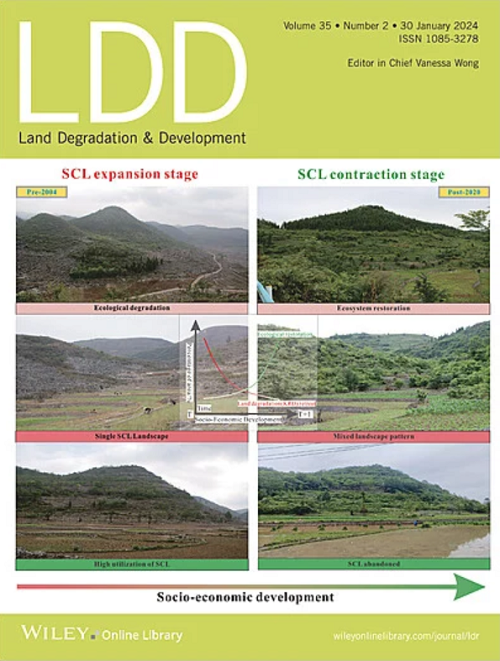Sixty Years of Sugarcane Monoculture Alters Carbon Preservation in Large Soil Macroaggregates in Tropical Soil
IF 3.6
2区 农林科学
Q2 ENVIRONMENTAL SCIENCES
引用次数: 0
Abstract
Frequent and intensive tillage in conventional agriculture disrupts soil aggregates, engendering significant depletion of soil organic carbon (SOC) stocks. Long-term studies are essential for assessing the impact of sustainable practices on aggregate dynamics and carbon sequestration in sugarcane monocropping in tropical ecosystems. The following hypothesis was first, conventional sugarcane management would degrade soil, thereby reducing C stocks and breaking down aggregates. Second, conservation management that involves reduced disturbance could restore C storage, reaching levels similar to those observed in native vegetation (NV) over time. Third, macroaggregation could be a key mechanism for C storage under conservation management. This study evaluated the distribution of SOC among distinct aggregate classes under conventional (CC) and minimum (MC) cultivation in a 60-year-old sugarcane system, comparing results with undisturbed NV. The monitored properties included aggregate mass, SOC content and stock, weighted average diameter (WAD), aggregate and C stability indexes (ASI and CSI), soil C–CO2 emissions, and C preservation capacity (CPC). The long-term CC had a significant impact on aggregate dynamics, manifesting in a reduction in macroaggregate mass and SOC content, an increase in CO2 emissions, and a decrease in CPC. While the total SOC stock remained comparable in NV and MC (76 Mg C ha−1), CC led to a 20% SOC loss. Although CC led to an increase in microaggregate C, it failed to counterbalance the loss of macroaggregate C. The ASI, with a reliability of approximately 99% in NV, exhibited a decline of 1% at 10 cm and 2% at 20 cm under MC and CC conditions. Concurrently, WAD reduced by 16% at 10 cm. CSI exhibited higher levels in NV and MC compared to CC at 10 cm depth. CPC in large macroaggregates was highest in NV (21 g kg−1), decreasing by 50% in CC (7 g kg−1) and by 33% in MC (14 g kg−1). At a depth of 20 cm, large macroaggregate mass was 28% lower in CC and 14% lower in MC compared to NV, resulting in a 29% and 21% reduction in macroaggregate C stock, respectively. In summary, the application of MC resulted in the preservation of SOC stocks at levels comparable to those observed in NV, thereby underscoring its capacity to maintain crop sustainability and augment carbon sequestration in tropical sugarcane systems.60年甘蔗单一栽培对热带土壤大团聚体碳保存的影响
传统农业中频繁和密集的耕作破坏了土壤团聚体,导致土壤有机碳(SOC)储量的显著耗竭。长期研究对于评估可持续做法对热带生态系统中甘蔗单一种植的总体动态和碳固存的影响至关重要。以下假设首先,传统的甘蔗管理会使土壤退化,从而减少碳储量,破坏团聚体。其次,减少干扰的保护管理可以恢复碳储量,随着时间的推移达到与原生植被(NV)相似的水平。第三,宏聚合可能是保护管理下C存储的关键机制。本研究以60年树龄甘蔗为研究对象,评价了常规栽培(CC)和最小栽培(MC)条件下土壤有机碳在不同团聚体类别中的分布,并与未受干扰的NV进行了比较,监测了团聚体质量、有机碳含量和储量、加权平均直径(WAD)、团聚体和碳稳定性指数(ASI和CSI)、土壤C - co2排放和碳保存能力(CPC)。长期CC对团聚体动态有显著影响,表现为大团聚体质量和有机碳含量降低,CO2排放量增加,CPC降低。虽然NV和MC的总SOC储量保持相当(76 Mg C ha - 1),但CC导致20%的SOC损失。虽然CC导致了微骨料C的增加,但它不能抵消大骨料C的损失。在NV中,ASI的可靠性约为99%,在MC和CC条件下,ASI在10 cm和20 cm处分别下降了1%和2%。同时,WAD在10厘米处降低16%。在10 cm深度,与CC相比,CSI的NV和MC水平更高。大团聚体的CPC在NV中最高(21 g kg - 1),在CC中下降50% (7 g kg - 1),在MC中下降33% (14 g kg - 1)。在20 cm深度,与NV相比,大骨料的CC和MC质量分别降低了28%和14%,导致大骨料C储量分别减少了29%和21%。综上所述,MC的应用使有机碳储量保持在与NV相当的水平,从而强调了其在维持作物可持续性和增加热带甘蔗系统碳固存方面的能力。
本文章由计算机程序翻译,如有差异,请以英文原文为准。
求助全文
约1分钟内获得全文
求助全文
来源期刊

Land Degradation & Development
农林科学-环境科学
CiteScore
7.70
自引率
8.50%
发文量
379
审稿时长
5.5 months
期刊介绍:
Land Degradation & Development is an international journal which seeks to promote rational study of the recognition, monitoring, control and rehabilitation of degradation in terrestrial environments. The journal focuses on:
- what land degradation is;
- what causes land degradation;
- the impacts of land degradation
- the scale of land degradation;
- the history, current status or future trends of land degradation;
- avoidance, mitigation and control of land degradation;
- remedial actions to rehabilitate or restore degraded land;
- sustainable land management.
 求助内容:
求助内容: 应助结果提醒方式:
应助结果提醒方式:


